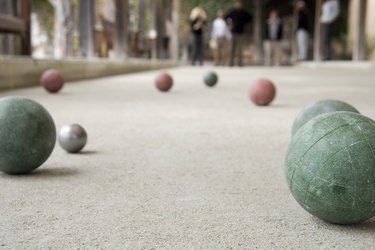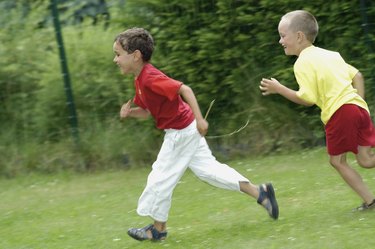
The history of Italian games begins with outdoor games that were brought to the Apennines peninsula from other cultures throughout the Mediterranean world. Archeological research demonstrates that the Romans played simple sports hundreds of years before they built their empire, and some of these old games are still played today. Other games, though invented more recently, have nevertheless acquired a measure of popularity that extends beyond Italy, a testament both to the enjoyment with which they are played and the ease with which they can be learned.
Outdoor Games
Video of the Day

If you have an adequately sized back yard, your guests can compete at bocce, an ancient Italian game with some similarities to soccer and bowling. The players are divided into two teams and each team is given four large balls. A smaller ball, known as the "jack" or "pallino," is rolled onto the green by the referee. Members of each team take turns rolling their bocci balls in the direction of the jack. Points are awarded to each team member who manages to get his ball closer to the jack than those on the opposing team.
Video of the Day
Card Games

Unlike the standard American card deck, the standard Italian deck has only 40 cards. Briscola can be played with an Italian deck or with an American deck from which the 8s, 9s, and 10s -- 12 cards in total -- have been removed. Cards are assigned number values, with the total adding up to 120 points. Aces have the highest value, at 11, followed by the number 3 card, worth 10 points, and then the king, worth four points, and the knight and jack, worth three and two points respectively. At the beginning of the game, each player is dealt three cards and a trump card is lain face-up on the table, clearly visible. The game proceeds in a counter-clockwise direction, which each player laying out a card on the table. The player who lays out the highest-value card during a round wins that round, and each player draws a new card from the top of the deck. The trump card, or briscola, is drawn last after all other cards in the deck have been drawn. At the end of the game, the winner is the player with the highest number of points.
Food and Food Games

Provide food for your guests by experimenting with traditional antipasti and appetizers. When they arrive, have an antipasti tray ready with provolone and mozzarella cheeses and a range of different meats, including salami, sausage, and a sliced ham known as prosciutto. Once they're situated comfortably, bring out appetizers -- calzones, frittatas or stuffed mushrooms -- followed by a main course. Incorporate food into your games by having guests write down an entree in secret that they feel best reflects their own personality, and take turns trying to guess what everyone has written.
Children's Games

Even if you're not hosting a party exclusively for children, children can still be included by having their own party corner presided over by one or more adults. In a traditional children's game, Lupo Mangia Frutta, one child is selected as a "wolf," while the others pretend to be different kinds of fruit. The children stand together side by side and call out, "What fruit do you want?" The wolf names a fruit, and the one who has chosen that fruit has to run from the safety of the line to a safe zone before being captured. Those who are captured become the wolf. In another traditional game known as "Piovra," the children stand a few feet away from an "octopus." When the signal is given, they run toward it while trying to avoid being captured. The octopus can move in only one direction.